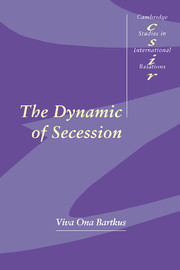Book contents
- Frontmatter
- Contents
- Acknowledgments
- I Introduction
- II The costs and benefits
- III The dynamic of secession
- 7 “Last resorts”: a rise in the costs of membership
- 8 “Opportune moments”: a reduction in the costs of secession
- 9 A reduction in the benefits of membership
- 10 A rise in the benefits of secession
- 11 Conclusion
- Bibliography
- Index
- CAMBRIDGE STUDIES IN INTERNATIONAL RELATIONS
7 - “Last resorts”: a rise in the costs of membership
Published online by Cambridge University Press: 22 September 2009
- Frontmatter
- Contents
- Acknowledgments
- I Introduction
- II The costs and benefits
- III The dynamic of secession
- 7 “Last resorts”: a rise in the costs of membership
- 8 “Opportune moments”: a reduction in the costs of secession
- 9 A reduction in the benefits of membership
- 10 A rise in the benefits of secession
- 11 Conclusion
- Bibliography
- Index
- CAMBRIDGE STUDIES IN INTERNATIONAL RELATIONS
Summary
What would tip the balance toward secession? On our metaphorical scales, the implicit and explicit restraints on secession – the benefits of membership and the costs of secession – counterbalance the motivations for secession – the costs of membership and the benefits of secession. But secession is change. It is a dynamic phenomenon. It can be thought of as the effect of motion on our metaphorical scales. Reduction in the barriers to secession could precipitate a secession crisis. Similarly, a rise in the forces for secession could also provoke a secession attempt. It is the balance between these costs and benefits that is critical. The next four chapters investigate each of the four possible cost or benefit shifts that can provoke a secession crisis. The purpose of this chapter is to unravel one of the most prevalent causal patterns. It traces outbreaks of secession to an objectionable rise in the costs of membership.
In these instances of rising membership costs, because the community regards the state as a threat, the decision to secede is one of “last resort.” Such pressures for secession can be divided into two categories: first, threats to the community's safety, and second, threats to its unique cultural inheritance. A brief investigation of the events before the Nigerian civil war of 1966–1970 and those leading up to the Bengali declaration of independence in March, 1971, reveals how such threats to safety provided the impetus for these two secessions.
- Type
- Chapter
- Information
- The Dynamic of Secession , pp. 117 - 144Publisher: Cambridge University PressPrint publication year: 1999

